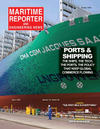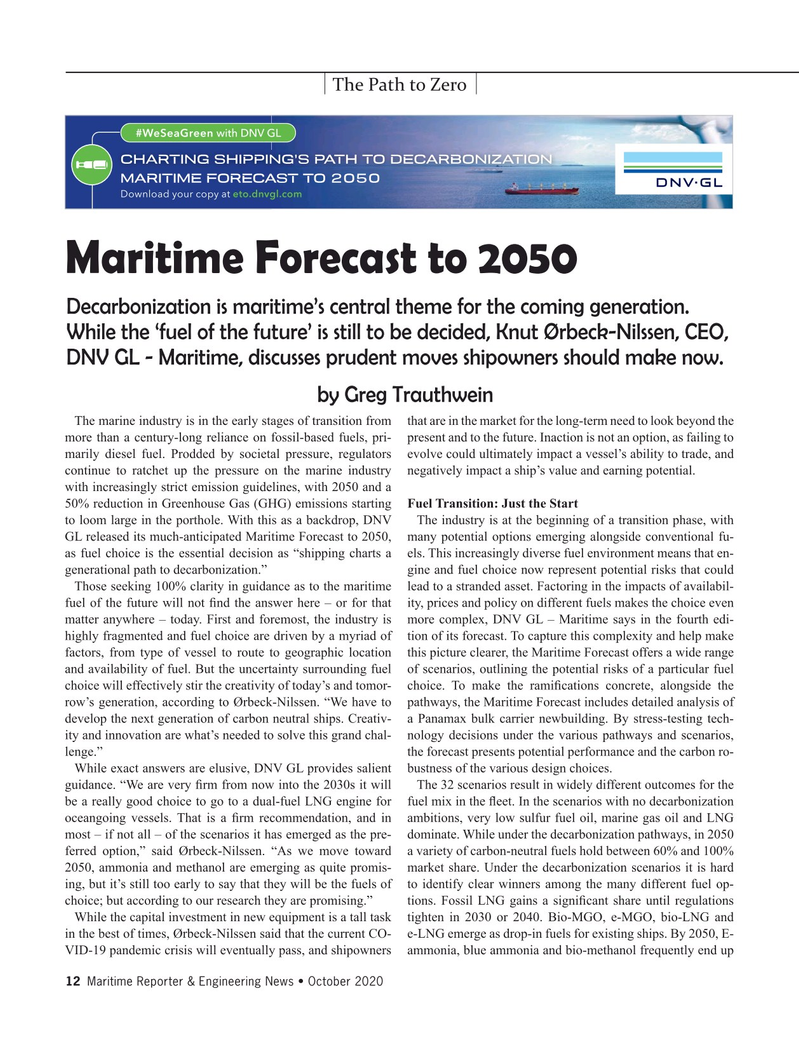
Page 12: of Maritime Reporter Magazine (October 2020)
Shipping & Port Annual
Read this page in Pdf, Flash or Html5 edition of October 2020 Maritime Reporter Magazine
The Path to Zero #WeSeaGreen with DNV GL
CHARTING SHIPPING’S PATH TO DECARBONIZATION
MARITIME FORECAST TO 2050
Download your copy at eto.dnvgl.com
Maritime Forecast to 2050
Decarbonization is maritime’s central theme for the coming generation.
While the ‘fuel of the future’ is still to be decided, Knut Ørbeck-Nilssen, CEO,
DNV GL - Maritime, discusses prudent moves shipowners should make now.
by Greg Trauthwein
The marine industry is in the early stages of transition from that are in the market for the long-term need to look beyond the more than a century-long reliance on fossil-based fuels, pri- present and to the future. Inaction is not an option, as failing to marily diesel fuel. Prodded by societal pressure, regulators evolve could ultimately impact a vessel’s ability to trade, and continue to ratchet up the pressure on the marine industry negatively impact a ship’s value and earning potential. with increasingly strict emission guidelines, with 2050 and a 50% reduction in Greenhouse Gas (GHG) emissions starting Fuel Transition: Just the Start to loom large in the porthole. With this as a backdrop, DNV The industry is at the beginning of a transition phase, with
GL released its much-anticipated Maritime Forecast to 2050, many potential options emerging alongside conventional fu- as fuel choice is the essential decision as “shipping charts a els. This increasingly diverse fuel environment means that en- generational path to decarbonization.” gine and fuel choice now represent potential risks that could
Those seeking 100% clarity in guidance as to the maritime lead to a stranded asset. Factoring in the impacts of availabil- fuel of the future will not ? nd the answer here – or for that ity, prices and policy on different fuels makes the choice even matter anywhere – today. First and foremost, the industry is more complex, DNV GL – Maritime says in the fourth edi- highly fragmented and fuel choice are driven by a myriad of tion of its forecast. To capture this complexity and help make factors, from type of vessel to route to geographic location this picture clearer, the Maritime Forecast offers a wide range and availability of fuel. But the uncertainty surrounding fuel of scenarios, outlining the potential risks of a particular fuel choice will effectively stir the creativity of today’s and tomor- choice. To make the rami? cations concrete, alongside the row’s generation, according to Ørbeck-Nilssen. “We have to pathways, the Maritime Forecast includes detailed analysis of develop the next generation of carbon neutral ships. Creativ- a Panamax bulk carrier newbuilding. By stress-testing tech- ity and innovation are what’s needed to solve this grand chal- nology decisions under the various pathways and scenarios, lenge.” the forecast presents potential performance and the carbon ro-
While exact answers are elusive, DNV GL provides salient bustness of the various design choices.
guidance. “We are very ? rm from now into the 2030s it will The 32 scenarios result in widely different outcomes for the be a really good choice to go to a dual-fuel LNG engine for fuel mix in the ? eet. In the scenarios with no decarbonization oceangoing vessels. That is a ? rm recommendation, and in ambitions, very low sulfur fuel oil, marine gas oil and LNG most – if not all – of the scenarios it has emerged as the pre- dominate. While under the decarbonization pathways, in 2050 ferred option,” said Ørbeck-Nilssen. “As we move toward a variety of carbon-neutral fuels hold between 60% and 100% 2050, ammonia and methanol are emerging as quite promis- market share. Under the decarbonization scenarios it is hard ing, but it’s still too early to say that they will be the fuels of to identify clear winners among the many different fuel op- choice; but according to our research they are promising.” tions. Fossil LNG gains a signi? cant share until regulations
While the capital investment in new equipment is a tall task tighten in 2030 or 2040. Bio-MGO, e-MGO, bio-LNG and in the best of times, Ørbeck-Nilssen said that the current CO- e-LNG emerge as drop-in fuels for existing ships. By 2050, E-
VID-19 pandemic crisis will eventually pass, and shipowners ammonia, blue ammonia and bio-methanol frequently end up 12 Maritime Reporter & Engineering News • October 2020
MR #10 (1-17).indd 12 10/6/2020 10:42:09 AM

 11
11

 13
13
